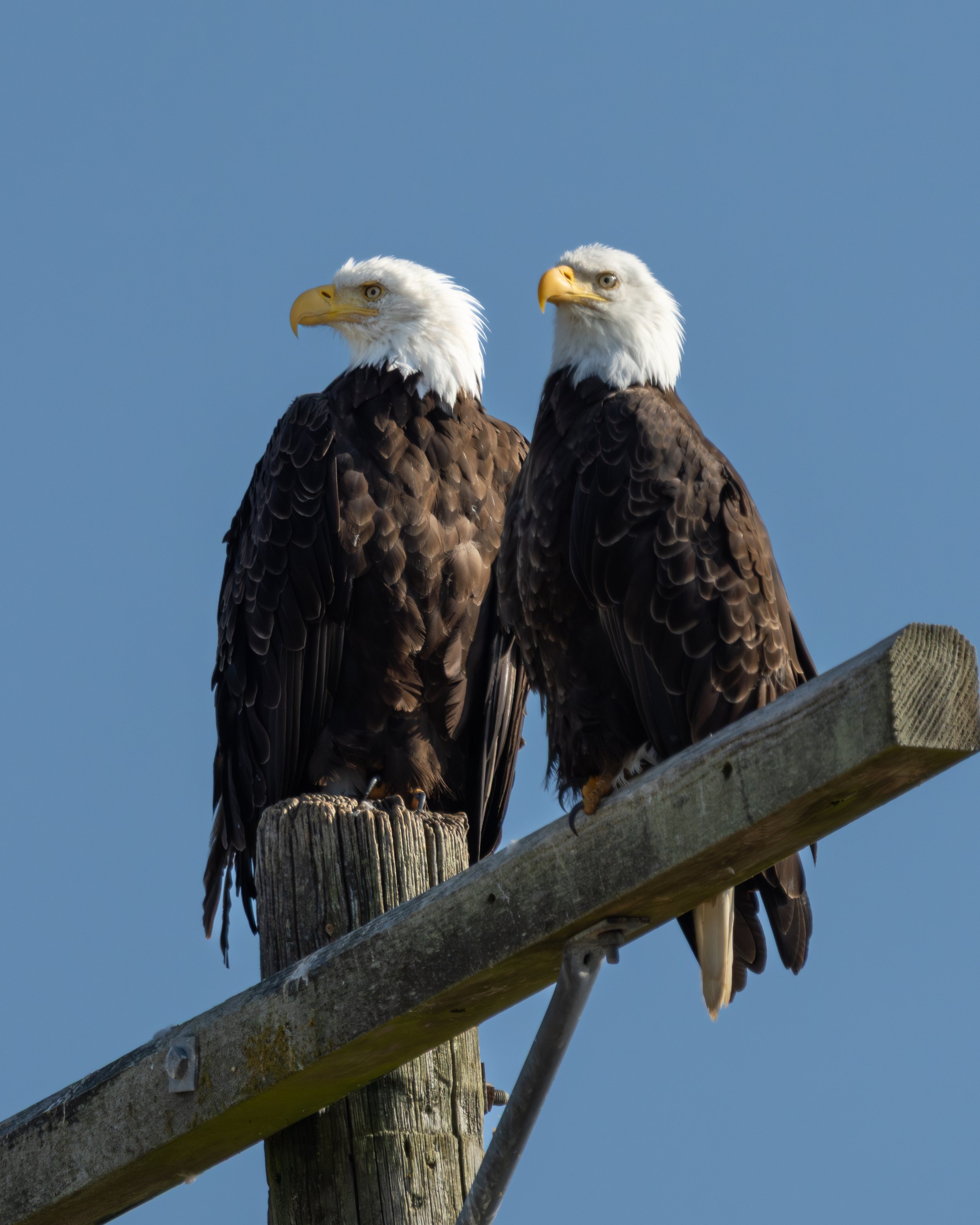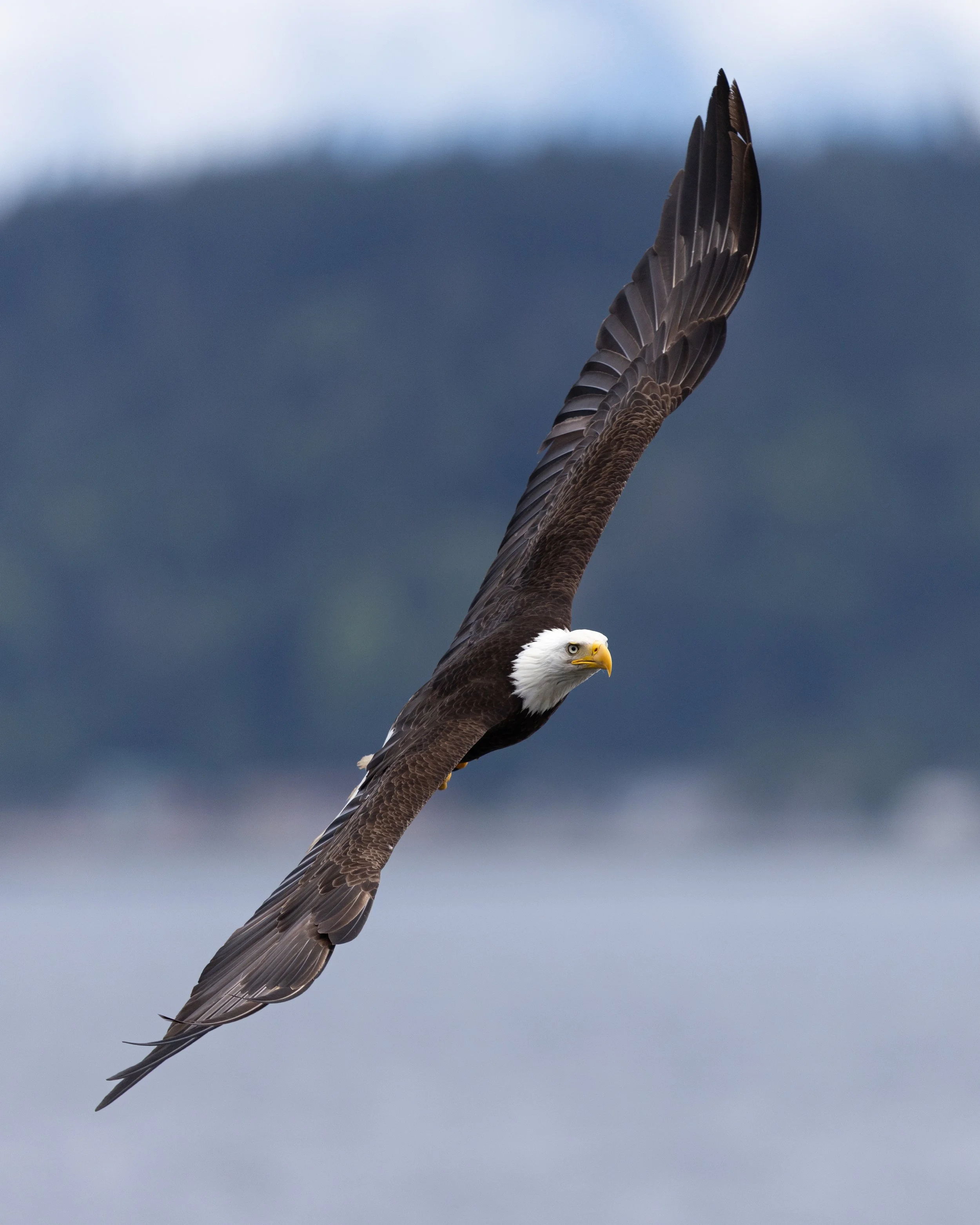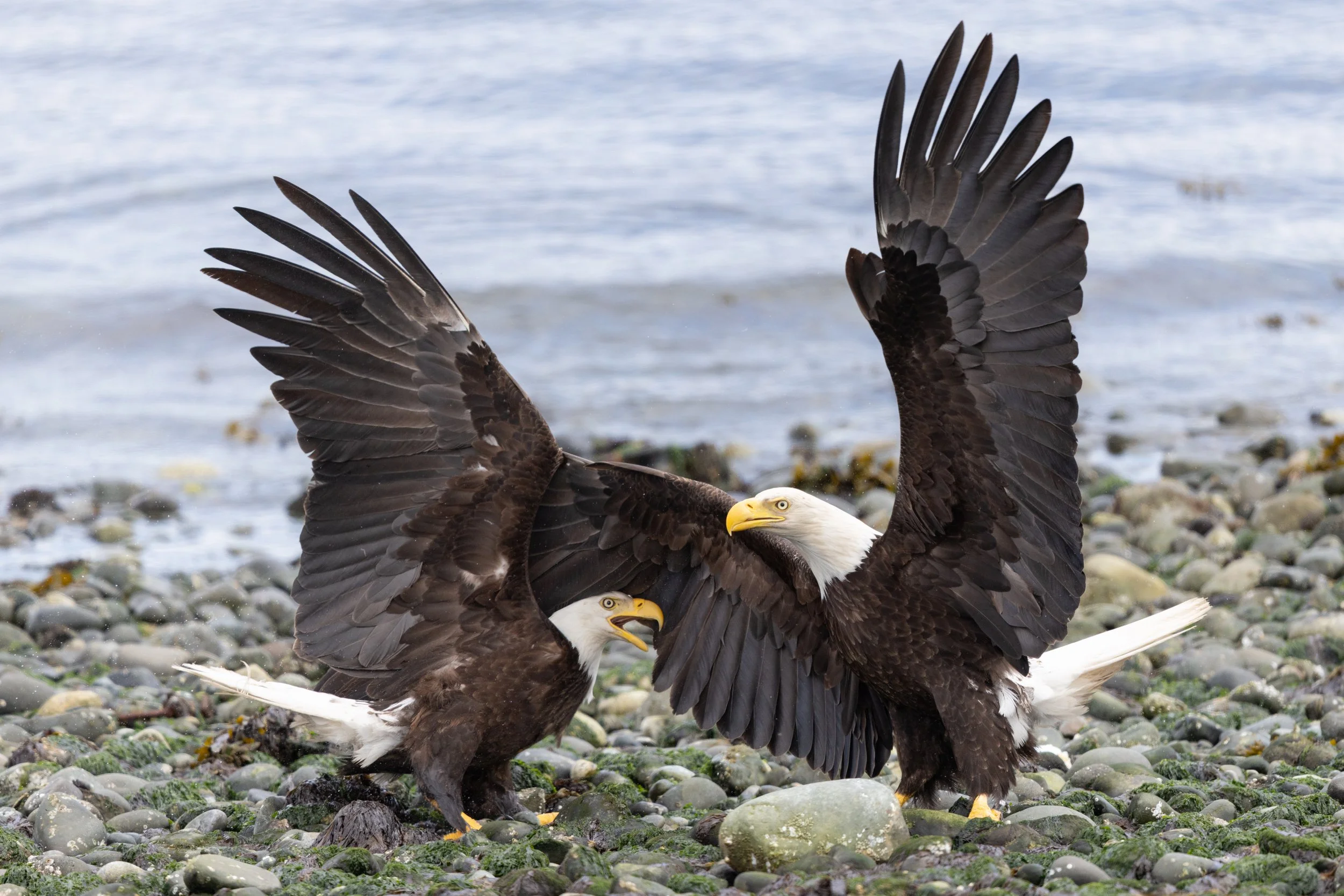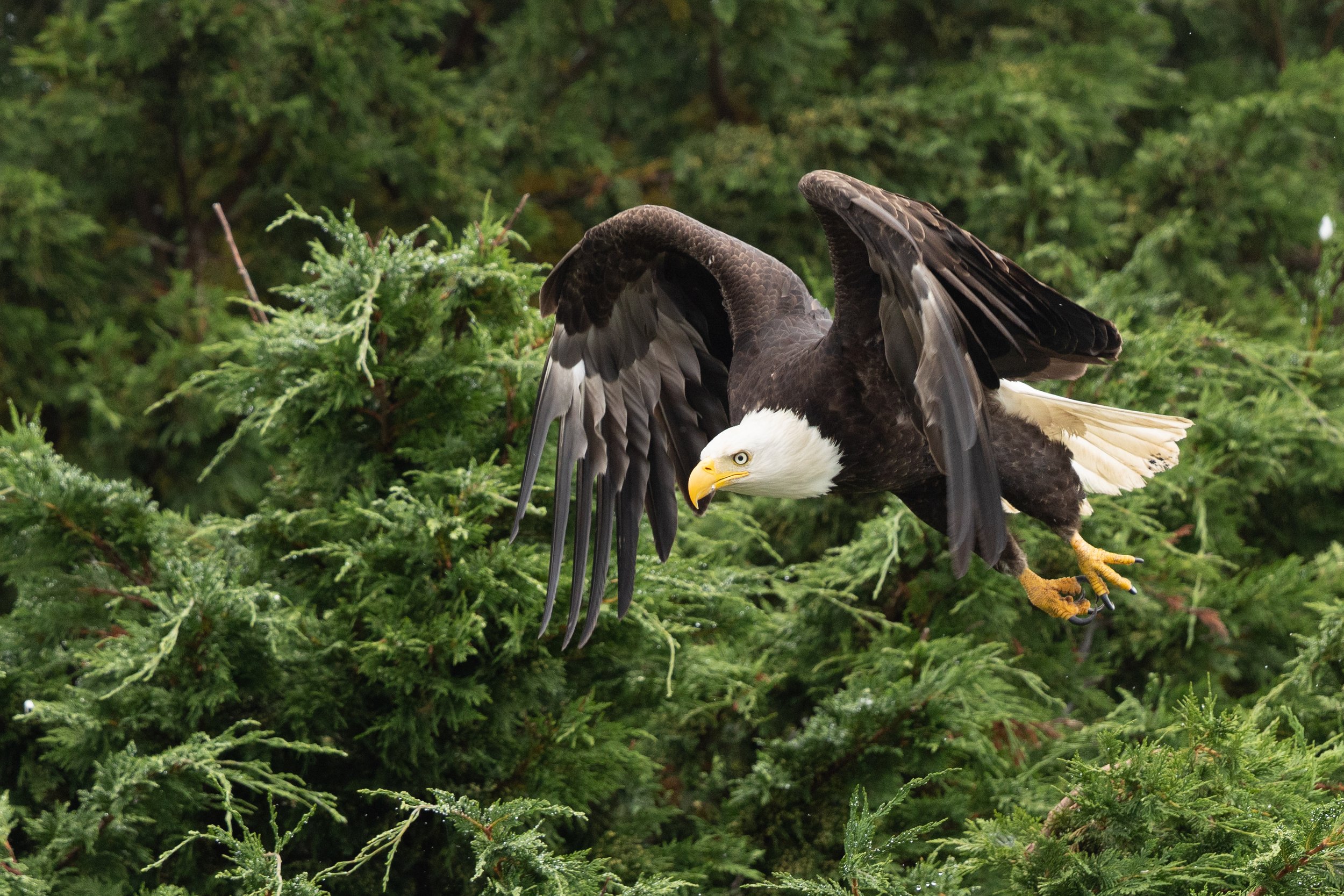Bald Eagle taking off along the shore in an industrial area. Certainly not the most beautiful background but it does tell a story.
Summer can be difficult for nature photographers, the spring migration is over and here on the wet coast we are eagerly awaiting the salmon to head up river as autumn arrives. Here in Campbell River we do have a huge number of Bald eagles along the coast in summer and they can be very active fishing off the coast or just grabbing leftovers from the fisher people as they come back from a day on the water. Although the best times of day for interesting light are early morning and as evening approaches, often these eagles are very active in the bright light of day. This can often make shooting eagles difficult as we can have deep shadows and very bright whites just on the eagle. Personally I like having some interesting shadows on some of my bird shots to give a bit more emphasis on the brighter portions but that does mean that I have to be picky about which shots have the light on the most interesting part of the bird….and that means shooting at high number of frames per second. This is a nice option to have as just a few years ago I was getting a maximum of 5 frames per second which meant I often missed that crucial moment when the eyes were in the light. Some of the latest cameras like the Canon R5II that I am using now allow me to get up to 30 frames per second and even allow for precapture so that I get up to 15 shots from before I pressed the shutter button. This really does mean that I come home with a much better chance of having the best shot possible on my memory card.
Eagle in flight on a bright day. Notice the shadows of the wing tips across its neck which gives an interesting added element to this shot. Taken with Canon R5 II with 500 f/4 at 1/4000s, f/4, ISO 320.
Bright days of summer do mean that you don’t necessarily need to have a large aperture telephoto prime to stop motion and get reasonably good detail in the shot. This allows for lenses like my 200-600 which has a maximum aperture of 6.3 at 600 to still be able to get shots at 1/2000-1/3000s at relatively low ISO which means minimal noise. This allows us to get interesting in flight and interaction shots relatively easily.
Adult bald eagle circling near a boat launch while a juvenile eagle sits on the rocks in the background. Taken with Canon R5 II with 500 f/4 at 1/4000s, f/4, ISO 500.
In flight eagle shots can be very fun to capture. Eagles here are often flying fairly low and banking around the beaches looking for fish. If you find a place where someone has left parts of fish after filleting their catches you can easily have a dozen eagles vying for a piece of the easy prize. The eagles also tend to stay around certain beaches as the tide recedes waiting to see what gets caught out of water. In these cases I have found that having a long telephoto zoom allows you to capture many of the fleeting moments that occur sometimes fairly close to you but also nice shots as the birds approach and circle around the scene. My usual starting camera setting for these situations are with the camera set to M (manual but not really), auto ISO (which is the not really), shutter speed of 1/2000s, and the aperture as open as possible. This allows for easy changes to the aperture if you have situations where you need a deeper depth of field, like trying to capture multiple birds interacting. It also allows for quick changes to shutter speed if you need it but still allows the camera to determine the ISO which will usually mean that you let the computer on board determine the exposure as the birds move in and out of the light. Depending on the exposure metering method and how well it obtains automagical exposures you can still change things with the exposure compensation more to your liking as you see your shots come out. Eagles can be difficult as you have white and very dark areas on the bird so it can be easy to blow out the whites on the eagles head if you aren’t paying attention.
Two juvenile eagles fighting over some salmon left on the beach. Because they were so close to the same distance from the camera they are mostly both in focus with the other eagles well out of the range of the depth of focus. Taken with Sony A7R5 with Sigma 500 f/5.6 at 1/2000s, f/5.6, ISO ??
Hot days in the summer do have one major issue for shooting long distances especially close to the ground/water. The further away you try to take a shot the more the atmosphere itself between you and the subject can reduce the perceived sharpness of your image. Especially over water you can often see a shimmering in the air and trying to take images through that is basically not going to produce the best results. Luckily this effect is reduced as you get closer to the subject but just be aware that you may not notice this effect as you are taking your shots until you get back to processing your images.
Pair of Bald Eagles on an old phone pole at the local spit. This portrait was taken while waiting for these guys to take off and hopefully do something interesting. Taken with Sony A7R5 and Sony 200-600mm at 600mm, f/6.3, 1/2000s, ISO 320. I could have reduced the shutter speed but since I was waiting for action I had it set at 1/2000s.
If you don’t get to see eagles often, you will likely be happy grabbing some beautiful shots of perched birds often as they are sitting on dead branches looking for their next meal or on the beach at low tide. You can get some fantastic portraits and environmental shots often of single eagles or of small groups of them together. In these cases I will often reduce my shutter speed to get the lowest ISO I can to reduce noise. Once you have those shots in the bag, then the birds in flight shots are often the next target. Although a few shot of the underside of an eagle as it passes over you are kind of fun, I have found the most interesting shots are as the eagle banks and turns. In these cases you can often get beautiful full wing spreads hopefully with the eagle looking towards you (or at least towards the water/ground but in your direction). If you can get the sun behind you a bit in these situations you should also be able to get a good bit of light on the eyes which will really help to liven up the image. As the eagles come down to the surface they will usually start to bring their legs down and open their talons. These can produce some interesting shots and if all goes well you might capture them as they grab a fish from the water or something interesting from the beach.
I managed to get many of the elements that I wanted in this shot, good light, grabbing a fish from the shallows, nice wing spread but I just missed in the wing position being able to see the eyes. The other shots were just before it grabbed the fish and then in the air. Taken with Canon R5II, 500mm +1.4 teleconverter, 700mm at f/5.6, 1/2500s, ISO320
If there is some competition for the food on the beach you will often be able to capture some interactions between the eagles (or eagles and turkey vultures, ravens, or gulls). In these cases a slight increase in your aperture value to increase the depth of field can help to get a shot with most of that action in focus. Determining the amount of increase in depth of field depends on the focal length of the lens, the distance from the subject and the sensor type. Having a tool on your phone like PhotoPills can help you to determine how much extra depth of field you can achieve but it is always going to mean that you have to give in to either higher ISO or lower shutter speed. I much prefer to deal with a bit more noise in these situations that to have blurry action due to slower shutter speeds but this is something you will need to determine for the situation you are in. If you have the time (and can move around the scene) you can improve your chances of getting things in focus by moving around until the birds are closer to the same plane of focus. This may not be possible if the action if happening quickly or you are on a cliff/waters edge.
As this eagle circled about I was able to get in a location that gave me nice light, and what I considered a nice background since the other directions were pure blue sky or houses along the shore.
If you have a choice of location then there are a couple other things to consider. The first for me is the direction of the sun, most of the time I prefer not shooting into the sun (there are always exceptions to this). The second for birds is the wind direction. Most eagles will tend to take off into the wind so if you want those shots you will have a higher chance if you put yours slightly upwind of the bird so that it takes off towards you. The last major thing I consider is the background and foreground of the shot. Once the other two conditions have been given me a general location then determining a nice background (and sometimes interesting foreground) can take a clean shot and make it a much more interesting one.
With the salmon leftovers on the beach quite a few eagles were fighting over the spoils. In this case I did not have many options for shooting locations as I had only a small spot on the beach to observe. With only a prime lens I had to choose for close up action shots at a high shutter speed.
I hope some of this helps anyone who is interested in photographing eagles. Here on Vancouver Island in the summer you will get many chances to practice and hopefully capture some fantastic shots.
A bit different shot with the wings half cocked and the cedar bows as a close background. This background isn’t too distracting since it is all one set of textures and colour shades.









